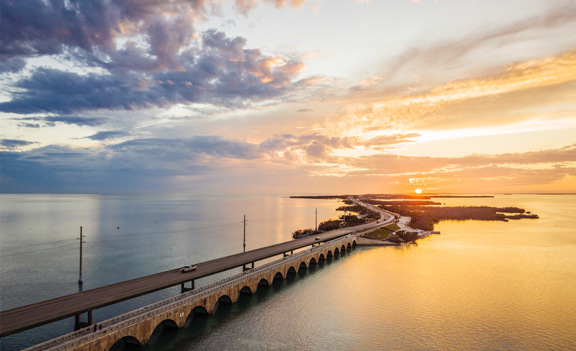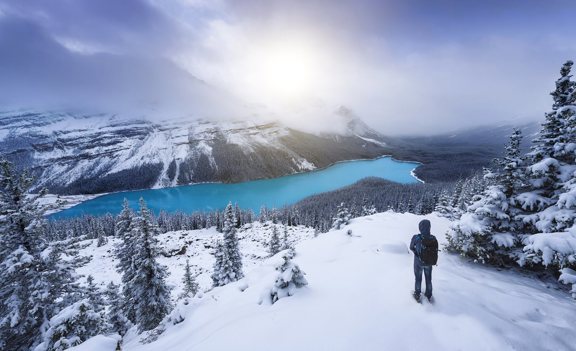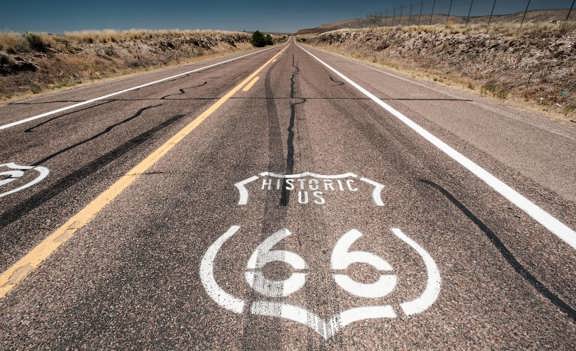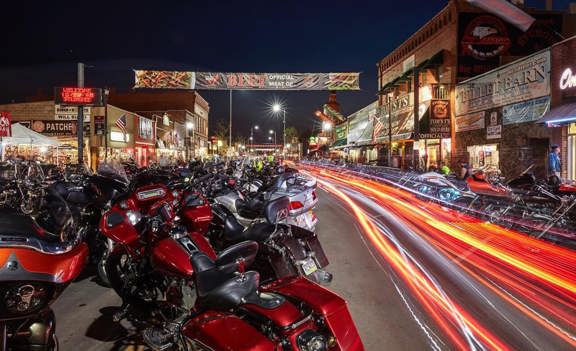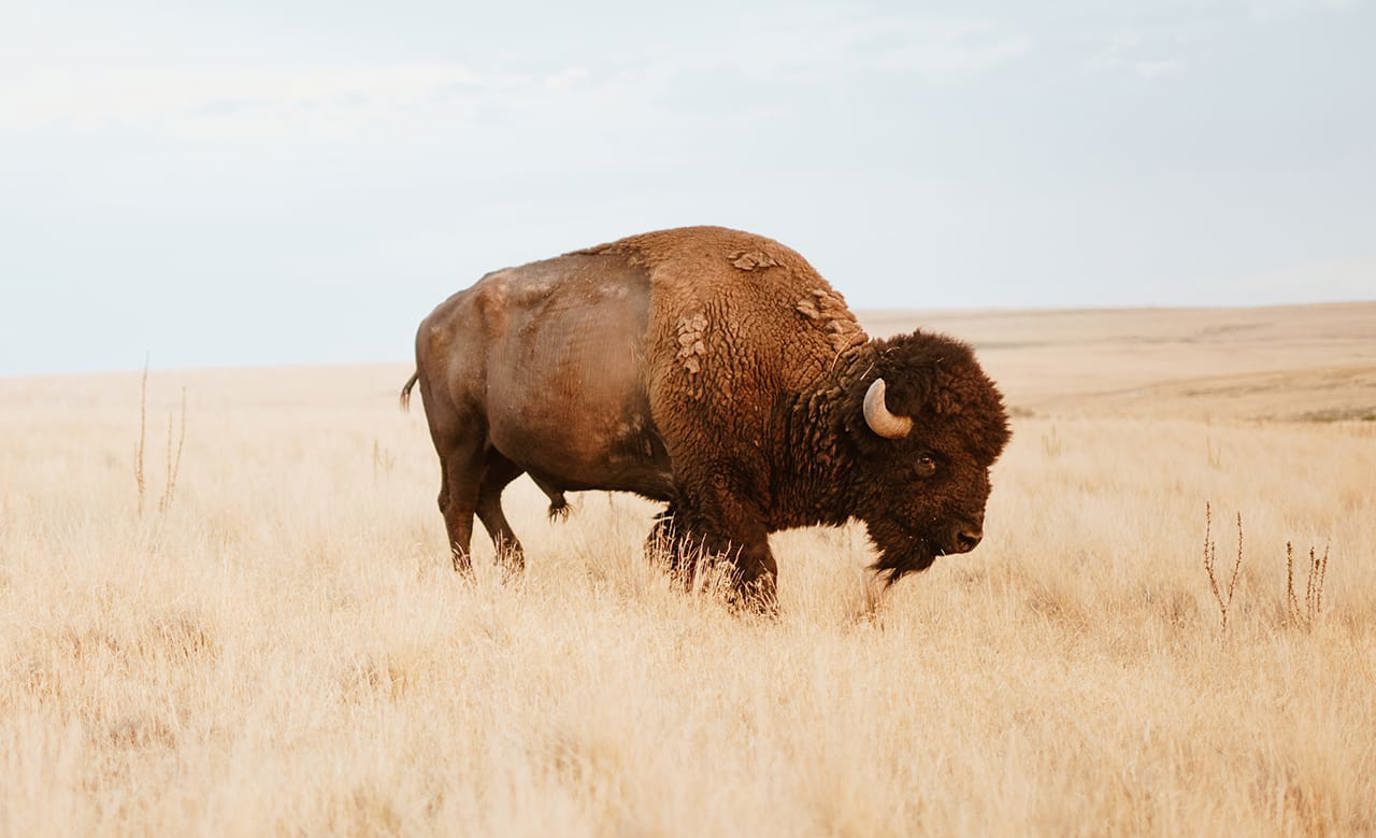
Route 66 isn’t just a road; it’s the original highway system that ran through the heart of America -- and it is rightfully celebrated for its rich history and cultural significance. After traversing the Midwest, travelers enter the Southwest, a region rich with desert landscapes, historic towns, and vibrant culture.
Route 66 traverses eight states from Chicago to Santa Monica, underscoring its national significance and the diverse experiences found along its storied path.
Stretching across Oklahoma, Texas, and New Mexico, this portion of the "Mother Road" introduces travelers to wide-open plains, charming Route 66 towns, and southwestern flair that’s distinctly different from the Midwest’s rolling fields and forested landscapes. From neon signs to adobe architecture, the Southwest portion of Route 66 embodies the spirit of adventure and Americana.
Route 66 Oklahoma: Prairie Charm Meets Roadside Americana
Route 66 Length in Oklahoma: ~400 miles
Key Cities Along the Route: Tulsa, Oklahoma City, El Reno, Claremore, and Miami
Oklahoma Route 66, also known as the Will Rogers Highway or Rogers Highway, is a historic highway that serves as the main street and main highway for many small towns across the state. This iconic path of transportation played a crucial role in American history, connecting communities and fostering commerce and migration. As Route 66 travels through Oklahoma, it passes through key intersections, such as where it meets other highways in Tulsa and Oklahoma City, linking cities and small towns alike.
Many portions of the old road, original road alignments, and historic road segments are preserved in Oklahoma, with several bridges and locations listed on the National Register of Historic Places. Along the way, travelers encounter small towns, quaint motels, and notable landmarks at nearly every location, including historic bridges and classic roadside attractions. The evolution of transportation along Oklahoma Route 66 is evident, from early automobiles to modern vehicles, all contributing to the enduring legacy of this legendary highway.
Top Attractions in Oklahoma on Route 66
-
Route 66 Museum (Clinton): Explore exhibits celebrating the history of the Mother Road at this location in Clinton, a small town along Route 66.
-
Blue Whale of Catoosa: A quirky, photogenic stop that’s become a Route 66 icon, located near the intersection of Route 66 and Azalea Drive.
-
Round Barn of Arcadia: A unique, circular barn built in 1898, perfect for a quick photo. This attraction is found in the small town of Arcadia.
-
Tulsa’s Art Deco District: Stunning architecture reflecting the city’s 1920s-30s boom, with several buildings listed on the National Register of Historic Places.
-
Historic Neon Signs in Miami: Capture classic roadside Americana with original neon in the small town of Miami.
-
Rock Creek Bridge (Sapulpa): This historic bridge, located just west of Sapulpa, is listed on the National Register of Historic Places and is a notable example of early 20th-century bridge engineering along Route 66.
-
Quaint Motels: Stay in charming, vintage motels found in small towns along Route 66, offering a nostalgic experience of the highway’s heyday.
Travel Tip: Oklahoma’s Route 66 offers RV-friendly campgrounds in cities like Tulsa and Oklahoma City, along with plenty of small-town RV parks perfect for exploring local diners and antique shops.
Route 66 Texas: The Panhandle’s Big Sky and Iconic Landmarks
Route 66 Length in Texas: ~180 miles
Key Cities Along the Route: Amarillo, Adrian, Vega
The Texas Route, part of the old route of Route 66, may have the shortest stretch of the historic highway, but it is packed with big skies, iconic stops, and western charm. This main highway served as the Main Street of many Texas towns, connecting communities and commerce across the Panhandle. Notable attractions include the U Drop Inn Cafe and Tower Station, a famous location in Shamrock that stands as an iconic symbol of the old road. Some road segments and road alignments in Texas preserve the original path of the historic highway, offering travelers a glimpse into the past.
The Texas Route 66 was among the first to be fully paved, making travel smoother for early motorists. In Amarillo, you can explore a one mile stretch filled with vintage signs and classic diners, highlighting the unique character of this legendary road. Known as the Texas Panhandle, this region has wide-open plains that offer a sense of freedom you can only get on the open road.
Top Attractions in Texas on Route 66
-
Cadillac Ranch (Amarillo): An artistic roadside installation of half-buried, graffiti-covered Cadillacs, located on a historic highway road segment just west of Amarillo. This site is found along a paved section of the old route, about one mile from the main highway.
-
Big Texan Steak Ranch: Famous for its 72-ounce steak challenge, a classic Route 66 experience on the main street of Amarillo, close to the historic highway's original alignment.
-
Midpoint Café (Adrian): Snap a photo at the exact midpoint of Route 66, the perfect Americana stop. This location marks the halfway point—1,139 miles from both Chicago and Santa Monica—on the old road.
-
Palo Duro Canyon State Park: The “Grand Canyon of Texas,” ideal for hiking, photography, and camping, is a short drive from a notable one mile stretch of preserved Route 66 road segments.
-
Vega’s Historical Route 66 Mural: Captures the essence of small-town Texas and the Mother Road, located on the main street in Vega along a paved section of the old route.
-
U Drop Inn Cafe & Tower Station (Shamrock): This iconic Art Deco landmark, built in 1936, is a must-see on the historic highway. Located at the intersection of Route 66 and US 83, the U Drop Inn Cafe and Tower Station are preserved attractions on the old route, serving as a symbol of the main street culture and the significance of Route 66 as the main highway through Shamrock.
Travel Tip: Texas offers RV parks and scenic campgrounds near Amarillo, giving travelers convenient access to local attractions while enjoying the wide-open landscapes.
Route 66 New Mexico: Desert Beauty and Cultural Richness
Route 66 Length in New Mexico: ~500 miles
Key Cities Along the Route: Albuquerque, Santa Rosa, Tucumcari
As Route 66 heads west through New Mexico, its path follows the historic highway that once served as the main highway connecting small towns and cities across the state. In many towns, Route 66 is still the main street, lined with vintage neon signs and classic diners. Several preserved old road segments and original road alignments can be found, especially in places like Tucumcari and Santa Rosa, where the old route showcases the nostalgic charm of the era.
Notably, New Mexico was among the first states to have its entire stretch of Route 66 fully paved, making travel smoother for early motorists. In Albuquerque, a one mile segment of Central Avenue features colorful murals and historic attractions, making it a key location for visitors exploring the route. Whether traveling east or west, the road offers a unique blend of desert landscapes, Pueblo culture, and southwestern art, with each mile revealing new stories and sights along this iconic path.
Top Attractions in New Mexico on Route 66
-
Old Town Albuquerque: Located along the old route of Route 66, this historic district features preserved road segments and paved streets that once served as the main street and main highway through Albuquerque. Explore historic streets, boutiques, and local cuisine in this iconic location on the historic highway.
-
Tucumcari Murals: Situated on a notable one mile stretch of the old road in Tucumcari, these colorful murals depict the history of Route 66. The murals line the main street, highlighting the town's location as a key stop along the historic highway.
-
Blue Hole (Santa Rosa): Found just off a paved section of the old route in Santa Rosa, this natural swimming hole is a popular location for travelers seeking a quick refresh on a hot day along the main highway.
-
Sandia Peak Tramway: Located near Albuquerque, this attraction is accessible from a preserved road segment of Route 66. It offers breathtaking views of the desert and mountains, making it a memorable stop along the historic highway.
-
Route 66 Neon Signs (Albuquerque): These vintage neon signs are found along the main street and old road alignments of Route 66 in Albuquerque. This location is perfect for evening photos capturing the nostalgic vibe of the historic highway.
Travel Tip: RV campgrounds are abundant in Albuquerque, and small-town parks offer easy access to historical sites, murals, and scenic desert drives. Travelers should plan for hot, dry days and bring plenty of water while exploring New Mexico’s desert stretches.
What Makes the Southwest Section of Route 66 Special
The Southwest portion of Route 66 is truly unique, offering travelers experiences they won’t find anywhere else on the Mother Road, also known as '66 the Mother Road' or 'Route 66 the Mother.'
This legendary route served as the main highway and historic highway connecting the Midwest to the West Coast, acting as the Main Street of America and linking other communities and small towns across the region. Unlike the Midwest, which features lush plains and forested landscapes, the Southwest showcases dramatic desert vistas, red-rock canyons, and endless open highways. This region is also steeped in Native American culture, cowboy history, and vintage Americana, making it a must-see for anyone seeking an authentic U.S. road trip experience.
Key highlights that make this stretch so memorable include:
-
Historic Towns: Many Route 66 towns in Oklahoma, Texas, and New Mexico preserve neon signs, old gas stations, and mid-century diners that transport visitors back in time. Many portions of the original road alignments and road segments are still intact, reflecting the rich history of the route.
-
Historic Places: The Southwest section features numerous historic places, including sites listed on the National Register of Historic Places, such as the U-Drop Inn in Shamrock, Texas, and the El Rancho Hotel in Gallup, New Mexico.
-
Cultural Richness: From Pueblo and Navajo influences in New Mexico to cowboy heritage in Texas, travelers experience diverse cultures along the route, with Route 66 serving as the main street for many communities.
-
Art and Quirky Stops: Murals, roadside sculptures like Cadillac Ranch, and the Blue Whale of Catoosa provide perfect photo opportunities.
-
Outdoor Adventure: From Palo Duro Canyon’s hiking trails to New Mexico’s Petroglyph National Monument, the Southwest offers natural beauty alongside its cultural attractions.
The Southwest’s preserved road segments, historic places, and vibrant communities all contribute to the legendary status and rich history of Route 66, making it an unforgettable journey through America’s past.
Can’t-Miss Things to Do in the Southwest
Traveling the Southwest portion of Route 66 isn’t just about driving—it’s about experiencing the rich history, culture, and iconic Americana that make this legendary route so special. Use travel guides and maps to plan can’t-miss activities along the historic highway, ensuring you don’t overlook any notable location, intersection, or historic place.
Along the way, you’ll discover quaint motels, charming small towns, and other communities that line the main street of America, each offering a unique glimpse into the past. Don’t miss the historic bridges and sites listed on the National Register, which are essential stops for any traveler. These experiences not only highlight the significance of Route 66 as a main highway but also offer a sense of new life and adventure as you journey mile after mile through the heart of the Southwest. Here are seven stops you absolutely can’t miss, each with its own unique charm and story:
1. Take a Selfie at the Blue Whale in Catoosa, Oklahoma
This quirky roadside attraction has been delighting Route 66 travelers since the 1970s. The giant blue whale sculpture sits along a small pond at the location of 2600 U.S. Route 66 in Catoosa, Oklahoma, just off the historic main street and near the intersection of Route 66 and N. 193rd East Avenue. While not listed on the national register of historic places, the Blue Whale is a beloved community landmark and a symbol of small-town charm along the Main Street of America.
Nearby, you’ll find quaint motels and the historic Catoosa railroad bridge, adding to the nostalgic atmosphere of this stretch of Route 66. Today, it’s a nostalgic symbol of the Mother Road and a perfect photo opportunity. Snap a selfie on the whale’s back, explore the surrounding park, and imagine the countless road trips that have passed by this icon over the decades.
2. Walk Among the Half-Buried Cadillacs at Amarillo’s Cadillac Ranch, Texas
Cadillac Ranch is a world-famous art installation featuring ten classic Cadillacs buried nose-first in the ground, located just west of Amarillo, Texas, along a notable one mile stretch of the historic highway Route 66. This location is easily accessible from the main highway and sits near a key intersection with I-40, following one of the original road alignments of Route 66. The area is fully paved, making it convenient for visitors. Nearby, travelers can find quaint motels that evoke the nostalgic charm of the Main Street of America.
Visitors are encouraged to grab spray paint and add their own personal touch to the colorful cars. The installation is set against the vast Texas Panhandle plains, making it visually striking and a must-see for photographers and art lovers alike. It’s a hands-on, interactive experience that perfectly captures the fun and creative spirit of Route 66.
3. Snap Photos of the Route 66 Murals in Tucumcari, New Mexico
Tucumcari is a small town overflowing with history and art, known for its large murals depicting Route 66 life. The murals are located along a notable one mile stretch of the historic highway's main street in downtown Tucumcari, on preserved and paved road segments that once formed part of the original road alignments of Route 66.
These colorful paintings cover buildings at this central location, telling stories of travelers, neon signs, quaint motels, and the classic Americana that Route 66, the Main Street of America, embodies. Walking through the murals is like stepping back in time, offering endless photography opportunities and Instagram-worthy moments.
4. Explore Palo Duro Canyon, Texas for Hiking and Breathtaking Views
Often called the “Grand Canyon of Texas”, Palo Duro Canyon is the second-largest canyon in the United States. Its location is just south of Amarillo, accessible from Route 66, the historic highway known as the "Main Street of America." The main highway provides easy access to the canyon via a paved road segment, about one mile south from the intersection of Route 66 and TX-217. With dramatic cliffs, colorful rock formations, and miles of trails, it’s ideal for hikers, bikers, and nature lovers. RV travelers can enjoy nearby campgrounds and quaint motels along the historic route while taking in sunset views over the canyon walls, making it a must-stop for adventure seekers.
5. Tour Old Town Albuquerque for Authentic Southwestern Food and Souvenirs
Old Town Albuquerque is the historic heart of the city, located at the intersection of Central Avenue (the original Route 66 main street) and Rio Grande Boulevard. This notable intersection marks Old Town's significance as a key point along the historic highway, once a main highway for travelers crossing the country. The area is fully paved, preserving its accessibility and charm. Surrounded by small towns and near several quaint motels, Old Town features adobe buildings, cobblestone streets, and a vibrant mix of shops and restaurants.
Travelers can browse handmade jewelry, Native American art, and Route 66 memorabilia, or stop for traditional New Mexican cuisine—think green chile cheeseburgers and sopapillas. This stop combines culture, history, and local flavor, making it a quintessential Southwest experience.
6. Visit Petroglyph National Monument, New Mexico
Petroglyph National Monument is located near Albuquerque, New Mexico, along the historic highway that once served as a main highway and symbolic main street for travelers across the region. While the monument itself is not listed on the National Register of Historic Places, it is recognized for preserving tens of thousands of ancient rock carvings left by Native Americans and early Spanish settlers. The access road to the monument is fully paved, making it easily accessible.
Visitors can explore trails winding through volcanic rock formations, viewing centuries-old symbols and images etched into the stone. This location offers a fascinating glimpse into the region’s history and culture, while also providing scenic hiking opportunities for all skill levels.
7. Stay in a Historic Route 66 Motel or Hotel
Travelers can fully immerse themselves in the nostalgia of Route 66 by spending the night in one of the quaint motels or historic hotels found along the paved sections of this historic highway, especially in the small towns scattered throughout Oklahoma, Texas, and New Mexico. Many of these accommodations are located right on the main street or main highway, offering not just a place to sleep but a direct connection to the vibrant history of Route 66.
From vintage neon signs and retro décor to friendly hosts sharing local stories, these locations provide a living connection to the Mother Road’s heyday. Iconic options include the El Rancho Hotel in Gallup, NM, a notable location on Route 66’s main highway, which famously hosted Hollywood stars filming westerns.
Southwest Route 66 Travel Tips & RV Guide
Traveling the Southwest stretch of Route 66, the historic highway often called the 'Main Street of America' and a main highway for generations, in an RV is an unforgettable experience. To make your trip smoother, safer, and more enjoyable, use travel guides and maps—including a map showing key intersections, one mile stretches ideal for RV stops, and the exact location of campgrounds and attractions.
Many RV parks are located on paved sections of the route, and you’ll also find quaint motels as alternative accommodations. Here’s how to make the most of your journey through Oklahoma, Texas, and New Mexico.
1. Recommended RV Campgrounds and Stops
The Southwest offers plenty of RV-friendly options that let you stay close to the action while enjoying scenic surroundings:
Oklahoma:
-
Blue Whale RV Park (Catoosa) – Located right on the historic highway, this campground sits just off a paved section of Route 66, next to the iconic Blue Whale attraction. It’s near the intersection of Route 66 and N 193rd E Ave, and within one mile of several quaint motels and classic diners.
-
Route 66 RV Park (Tulsa) – Conveniently situated along the main highway, this full-service park is ideal for travelers exploring Tulsa’s Route 66 attractions. It’s close to the intersection of Route 66 and S 193rd E Ave, and just a short mile from the heart of Tulsa’s main street, where you’ll find historic buildings and quaint motels.
Texas:
-
Cadillac Ranch RV Campgrounds (Amarillo area) – Located on a paved stretch of the historic highway, this campground is close to the famed Cadillac Ranch art installation. It’s within one mile of Amarillo’s historic district, where you’ll find a mile-long stretch of art galleries and vintage shops along main street, as well as several quaint motels.
-
Palo Duro Canyon State Park Campgrounds (Canyon, TX) – A beautiful park with full hook-up RV sites, hiking trails, and stunning canyon views. The campground is just a few miles from the intersection of the main highway and TX-217, making it a convenient stop for those traveling the historic highway.
New Mexico:
-
Tucumcari RV Park – Centrally located on Route 66’s main street, this park is a hub for exploring murals and historic downtown attractions. It’s on a paved section of the historic highway and within one mile of several quaint motels that capture the nostalgia of classic road trips.
-
Laguna Pueblo RV Park (Albuquerque area) – Offers convenient access to Old Town Albuquerque and Petroglyph National Monument. The campground is near the intersection of the main highway and NM-45, and is located on a paved stretch of the historic highway.
-
Gallup RV Resort – Perfect for visiting the historic El Rancho Hotel and exploring local arts and culture. This resort is located on the main street of Gallup, just off a paved section of Route 66, and within one mile of several quaint motels and key intersections that connect travelers to other regional attractions.
2. Scenic Detours Worth the Extra Miles
The Southwest is filled with landscapes and roadside attractions that are worth a short detour:
-
Route 66 through the Texas Panhandle Plains – Located along a paved section of the historic highway, this stretch covers one mile of wide open skies and endless horizons, perfect for classic Americana photos. The main highway here passes through Amarillo, where you’ll find quaint motels and the famous intersection with US-287.
-
Mount Taylor, New Mexico – Visible from the main highway, this volcanic peak is a stunning backdrop for photos and offers hiking opportunities. The location is just off Route 66, near the intersection with NM-117, and is easily accessible from the paved main street of Grants.
-
Painted Desert & Petrified Forest National Park (just north of Route 66) – This scenic detour is located about one mile north of the historic highway, near the intersection of Route 66 and US-180. The area features colorful badlands and ancient petrified wood, with several quaint motels nearby for an overnight stay.
-
Conchas Lake State Park, New Mexico – Situated a few miles off the main street of Tucumcari, this peaceful spot is accessible via a paved road from the historic highway. The location is ideal for kayaking, picnicking, or just a scenic RV stop, with several quaint motels in the vicinity.
3. Route Planning and Travel Pacing
The Southwest stretch of this historic highway is longer and can feel remote at times, so pacing your trip is key:
-
Recommended pace: 3–5 days for Oklahoma → Texas → New Mexico, depending on stops along this main highway.
-
Daily driving: Aim for 150–250 miles per day to give yourself enough time to explore attractions, take photos, and relax at campgrounds. Consider breaking up your drive with stops every one mile or so to experience unique roadside sites and small-town main street charm.
-
Route planning: Use maps or a map showing the route to plan your journey, identify paved sections, and locate key landmarks.
-
Timing tips:
-
Spring and Fall are ideal for moderate temperatures and less crowded attractions.
-
Early mornings are perfect for photographing the iconic Route 66 landmarks and avoiding heat in desert areas.
4. Insider Tips for Southwest Route 66 RV Travelers
-
Stay fueled up: Gas stations can be few and far between, especially along the historic highway’s rural Texas and New Mexico stretches. Use travel guides and maps to locate fuel stops and services, especially at key intersections and on paved sections of the main highway.
-
Pack essentials: Sunscreen, water, snacks, and a well-stocked first aid kit are a must.
-
Plan your food stops: Explore local diners, roadside cafes, and unique eateries for authentic Southwestern cuisine. Many are found right on the main street or within one mile of major attractions.
-
Check RV park reservations: Some of the popular campgrounds fill quickly, especially on weekends. Maps and travel guides can help you find the exact location of RV parks and quaint motels as alternative accommodations.
-
Embrace spontaneity: One of the joys of Route 66 is discovering offbeat attractions, antique shops, and local festivals you didn’t know existed. A map showing notable miles and intersections will help you plan stops and explore hidden gems along the route.
With the right planning, traveling the Southwest portion of Route 66 by RV becomes an adventure filled with history, culture, and unforgettable scenery. Every stop—from quirky roadside art to stunning natural landscapes—is a chance to immerse yourself in the heart of Americana.
Southwest Route 66 FAQ
1. How long is Route 66 through the Southwest?
The Southwest stretch of Route 66 covers approximately 900 miles, forming a key segment of the historic highway that traverses eight states from Illinois to California. This section runs through the location of Oklahoma, the Texas Panhandle, and New Mexico. For planning your journey, consider using a map or maps—a map showing the route can help you visualize each mile and highlight notable stops, including stretches as short as one mile that feature unique attractions. Depending on your stops, you’ll want 3–5 days to explore this region comfortably by RV.
2. What are the best months to travel this portion of Route 66?
-
Spring (March–May): Mild temperatures, blooming wildflowers, and fewer crowds.
-
Fall (September–November): Cooler desert temperatures, ideal for hiking and RV travel.
-
Summer: Can be extremely hot in Texas and New Mexico; early morning or late afternoon travel is recommended.
-
Winter: Mild weather in New Mexico, but some attractions or campgrounds may close.
3. Are there unique local foods I should try?
Yes! Don’t miss:
-
Oklahoma: Chicken-fried steak, barbecue, and local diners.
-
Texas: Tex-Mex dishes, chili, and Amarillo’s famous steak sandwiches.
-
New Mexico: Green chile, sopapillas, and Navajo fry bread.
4. Is the Southwest stretch safe for RV travel?
Absolutely! Follow these tips:
-
Keep extra water and fuel in remote areas.
-
Stick to daytime driving in less-populated stretches.
-
Check weather reports for desert conditions, particularly in summer.
5. How much driving should I plan per day?
-
150–250 miles/day is ideal, allowing time to explore attractions, stop for meals, and take photos. For some stretches, driving just one mile can reveal unique landmarks or art galleries, especially in locations like Amarillo or near the Pacific Ocean in Santa Monica.
-
Use a map or maps for planning your trip, and consider a map showing the route to identify the exact location of recommended stops, detours to natural landmarks, historic sites, or quirky roadside attractions.
6. How do I find offbeat or hidden Route 66 attractions?
-
Use travel guides and maps to discover offbeat attractions and hidden gems along the historic highway. Apps like Roadtrippers or Atlas Obscura often include a map showing the exact location of unique stops, including those found on paved sections of Route 66.
-
Pay attention to notable mile markers or one-mile stretches, as these often highlight clusters of attractions or key intersections with other highways and main streets, making it easier to plan your stops.
-
Follow local tourism boards in Oklahoma, Texas, and New Mexico for seasonal events and updates on the best locations to visit, including quaint motels that offer a nostalgic stay along the main highway.
-
Look for historic diners, vintage motels, and neon signs along the route for authentic roadside Americana.
Travel The Mother Road With Cruise America
No matter which stretch of Route 66 you’re exploring, the freedom of the open road is best experienced from the comfort and convenience of an RV. Cruise America makes it easy to hit the “Mother Road” on your own schedule—whether you’re chasing quirky roadside attractions, historic diners, or breathtaking desert landscapes.
With fully equipped RVs ready for adventure, flexible rental options, and a nationwide network of locations, Cruise America is the perfect companion for anyone looking to explore Route 66 the way it was meant to be experienced—at your pace, with all the comforts of home on the road. Book today!
